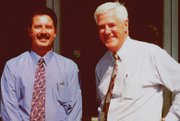Gerber Sees Growth Source in Customer Service
At a time when some apparel technology companies are backing away from selling big-ticket items and expenses like service contracts, Gerber Technology, which counts cutting-room equipment and service contracts as its bread and butter, is running counter to the trend with a host of programs designed to use new technologies to aid in old-fashioned customer service.
The Tolland, Conn.-based company is confident about the future despite suffering a 15 percent drop in sales in 2001, which the company attributes to declines in the U.S. and European apparel markets and fluctuating currency rates. The company instituted a restructuring plan that included cutting 25 percent of its work force and has been continuing to expand into offshore markets like China, India, Mexico and the Caribbean basin. Executives say the strategy has positioned Gerber for improved profitability going forward.
At the company’s Los Angeles office, Warren Hartenstine, regional sales manager, has seen challenges galore as the local apparel industry remains pressured by offshore competition and a slowing economy. Locally, apparel and sewn goods comprise 65 percent of Gerber’s business compared to only 20 percent nationally. Gerber is now refocusing on gaining accounts in the flexible-materials industry, which provides components for racecars, aerospace and other industries. It has also found growth pockets in upholstery, leather goods and with its B2B e-commerce initiative web PDM, a production data management software program.
The company sees further growth potential in customer service; which Gerber executives say is key to maintaining and gaining market share.
Corporate-wide, the company is about to embark on a new service initiative called Customer First, which is aimed at putting all levels of management on the same page when it comes to satisfying customers. With Customer First, any customer complaint, for example, would be copied to all levels of management, including Gerber president Mark Giles. The objective is to put Gerber executives in touch with people in the field and, ultimately, the customer.
“Good service is always advantageous over sales,” said Richard Aumend, Gerber’s Western service manager. “People will call you more if you do better.”
This summer Gerber introduced e-Nester, a Web-based tool catering to smaller manufacturers who can send markers via e-mail to Gerber for completion on a pay-per-marker basis.
This complements recent additions to Gerber’s around-the-clock Web-based services including Gerberparts and Gerberprism, which give customers troubleshooting tools over the Web to help them diagnose and repair systems.
Gerber also recently launched one of its first “e-groups,” which links customers together in Internet-based news groups, allowing each group to share knowledge and information.
While Gerber still believes in selling service contracts—its research shows that four out of five customers would pay 30 percent more if they paid on a time-and-materials basis—the company doesn’t push contracts in a big way.
“We don’t force them,” said Hartenstine. “In fact, our salespeople don’t get paid for service contracts. But we look at [a service contract] as something like car insurance. If you drive down the road without insurance, sooner or later you’re going to crash.”
Gerber also runs a service training program at its Connecticut headquarters, where for $2,500 companies can send an employee to learn to service their Gerber equipment.
Hartenstine and Aumend link contracts with value. “I don’t know how many times I visited one client over the past month, but it doesn’t matter to the customer. It’s all covered,” explained Aumend, who manages field service engineers in Los Angeles as well as in Seattle, Salt Lake City, the Bay Area and Vancouver, British Columbia.
“It comes down to getting excellent technical service,” Hartenstine concluded. “It’s like when you go to a Best Buy and get all their technical expertise for one price. It’s worth it.”






















